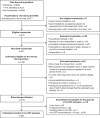Population-based study of high plasma C-reactive protein concentrations among the Inuit of Nunavik
- PMID: 23087913
- PMCID: PMC3475996
- DOI: 10.3402/ijch.v71i0.19066
Population-based study of high plasma C-reactive protein concentrations among the Inuit of Nunavik
Abstract
Background: The shift away from traditional lifestyle in the Inuit population over the past few decades has been associated with an increased prevalence of coronary heart disease (CHD) risk factors such as obesity, high blood pressure (BP) and diabetes. However, the impact of this transition on the pro-inflammatory marker high-sensitivity C-reactive protein (hs-CRP) has not been documented.
Objectives: To examine the prevalence of elevated plasma hs-CRP concentrations in Inuit from Nunavik in the province of Quebec (Canada) and identify anthropometric, biochemical and lifestyle risk factors associated with elevated hs-CRP.
Design: A population-representative sample of 801 Inuit residents from 14 villages of Nunavik, aged between 18 and 74 years, was included in the analyses. Subjects participated in a clinical session and completed questionnaires on lifestyle. Multivariate logistic regression was used to determine risk factors for elevated hs-CRP.
Results: Elevated plasma hs-CRP concentrations (≥ 2 mg/L) were present in 32.7% (95% confidence interval (CI) 29.5-35.8) of the Inuit adult population and were more prevalent among women than among men (36.7% vs. 29.0%, p=0.007). Multivariate logistic regression analysis indicated that every 1 mmHg increase in systolic BP was associated with a 3% increase in the odds of having hs-CRP concentrations ≥ 2 mg/L in the Inuit population (95% CI 1.01-1.04). The combination of older age (≥ 50 vs. <30 years) and elevated waist circumference (gender-specific cut-off values) in a multivariate logistic model was also associated with a 13.3-fold increase in the odds of having plasma hs-CRP concentrations ≥ 2 mg/L (95% CI 5.8-30.9).
Conclusions: These data indicate that elevated hs-CRP is relatively prevalent among Inuit with values that are similar to those seen in Canadian Caucasian populations. Sex, age, waist circumference and systolic BP are major factors that increase the risk of this inflammatory phenotype among Inuit from Nunavik, despite their different lifestyle background compared with Caucasians.
Keywords: C-reactive protein; Inuit; Nunavik; aging; prevalence; risk factors; sex; systolic blood pressure; waist circumference.
Figures



References
-
- Sharma S. Assessing diet and lifestyle in the Canadian Arctic Inuit and Inuvialuit to inform a nutrition and physical activity intervention programme. J Hum Nutr Diet. 2010;23(Suppl 1):5–17. - PubMed
-
- Dewailly E, Chateau-Degat ML, Ekoé JM, Ladouceur R, Rochette L. Québec, Canada: Gouvernement du Québec – Institut national de santé publique du Québec (INSPQ) & Nunavik Regional Board of Health and Social Services (NRBHSS); 2007. Status of cardiovascular disease and diabetes in Nunavik. Nunavik Inuit Health Survey 2004, Qanuippitaa? How are we?
-
- Chateau-Degat ML, Dewailly E, Charbonneau G, Laouan-Sidi EA, Tremblay A, Egeland GM. Obesity risks: towards an emerging Inuit pattern. Int J Circumpolar Health. 2011;70:166–77. - PubMed
-
- Ayach BB, Korda H. Commentary: type 2 diabetes epidemic in first nations people of Canada. Ethn Dis. 2010;20:300–3. - PubMed
-
- Koenig W, Sund M, Frohlich M, Fischer HG, Lowel H, Doring A, et al. C-reactive protein, a sensitive marker of inflammation, predicts future risk of coronary heart disease in initially healthy middle-aged men – results from the MONICA (Monitoring Trends and Determinants in Cardiovascular Disease) Augsburg cohort study, 1984 to 1992. Circulation. 1999;99:237–42. - PubMed
Publication types
MeSH terms
Substances
Grants and funding
LinkOut - more resources
Full Text Sources
Medical
Research Materials
Miscellaneous
